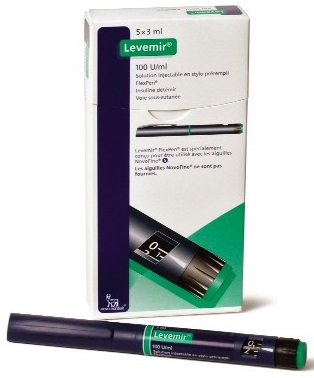Contents
- What is Lantus? What is Levemir?
- Are Lantus and Levemir same thing?
- How do Lantus and Levemir work?
- Lantus and Levemir Uses
- Lantus and Levemir available dosages and forms
- Lantus side effects
- Levemir side effects
- Can you buy Lantus and Levemir over the counter?
- Lantus and Levemir price
- Who can use these products?
- How should Lantus and Levemir be used?
- How many times and how often can patients take Lantus and Levemir?
- What if I overdose Lantus and Levemir?
- What if I missed the dose of Lantus and Levemir?
- Can I drink alcohol while taking Lantus and Levemir?
What is Lantus? What is Levemir? |
|
| Lantus is a Brand name for a man-made hormone product form called insulin glargine. It works by lowering glucose levels in blood. It is a long-acting form of insulin, a slightly different from other insulin forms that are not man-made. Lantus is used to for the treatment of diabetes type 1 and type 2.
Levemir is a Brand name for a man-made hormone product form of insulin called insulin detemir. It works by lowering glucose levels in blood. It is a long-acting form of insulin, a slightly different from other insulin forms that are not man-made. Levemir is used for the treatment of type 2 diabetes in adults. Levemir can be also used to treat type 1for the treatment of diabetes type 1 in adults and children who are at least 2 years old. |
|
Are Lantus and Levemir same thing? |
|
| Lantus and Levemir do have many similarities but they are not the same thing. They are both man-made long-acting form of insulin and they are both used for the treatment of diabetes type 1 and 2, and they are intended for daily management. Studies showed no significant difference in the effectiveness and safety of Lantus and Levemir for the treamtnent of type 2 diabetes.
They’re both absorbed slowly over a 24-hour period. Both products are basal insulin formulas, which mean that sugar levels in blood are lowered more slowly but they last much longer. They act as background insulin, with a slow feed that mimics the constant low insulin output produced by a healthy pancreas. They are not used to correct sugar spikes or to treat diabetic ketoacidosis. Ketoacidosis treatment requires short-acting insulin. However, there are some differences. Levemir is an insulin detemir solution, while Lantus is an insulin glargine solution. Insulin glargine -Lantus is made by recombinant DNA technology by using a non-pathogenic laboratory Escherichia coli (K12) strain as the production organism. Insulin detemir – Levemir is produced by using recombinant DNA technology in yeast cells. Compared to glargine, insulin detemir does not form a precipitate upon injection. Detemir effects are extended because its altered form makes it stick to itself in the subcutaneous depot, so it is slowly absorbed. When insulin detemir molecules are dissociated, they readily enter the blood circulation, but there the added fatty acid in insulin molecule binds to albumin. |
|
How do Lantus and Levemir work? |
|
| Both, Lantus and Levemir work by immitating basal levels of insulin in patients with diabetes. Insulin is produced by beta cells of the pancreas. In healthy individuals, a basal level of insulin is supplemented with insulin spikes during meals. Insulin’s increased secretion during meals is responsible for the metabolic changes that occur as the body transitions from a post – absorptive to absorptive state.
Insulin promotes glucose cellular uptake, particularly in adipose and muscle tissues, promotes energy storage through glycogenesis, increases DNA replication and protein synthesis by stimulating amino acid uptake by liver, muscle and adipose tissue, reduces catabolism of energy stores and modifies numerous enzyme activities involved in glycogen synthesis and glycolysis. Insulin is required for protein synthesis, DNA synthesis and cell division. |
|
Lantus and Levemir Uses |
|
|
|
Lantus and Levemir available dosages and forms |
|
|
|
Lantus side effects |
Levemir side effects |
|
|
Can you buy Lantus and Levemir over the counter? |
|
| No, Lantus and Levemir are available only as prescription products. | |
Lantus and Levemir price |
|
|
|
Who can use these products? |
|
|
|
How should Lantus and Levemir be used? |
|
|
|
How many times and how often can patients take Lantus and Levemir? |
|
|
|
What if I overdose Lantus and Levemir? |
|
|
|
What if I missed the dose of Lantus and Levemir? |
|
|
|
Can I drink alcohol while taking Lantus and Levemir? |
|
| It is generally recommended that patients using insulins abstain alcohol consuming, as it cancan cause hyperglycemia or hypoglycemia in patients with insulin-dependent diabetes. Hypoglycemia is more likely to occur in patients who are chronic drinkers of large quantities of alcohol, and it can also occur after binge or moderate drinking, specifically when alcohol is consumed on an empty stomach.
However, if alcohol in some cases cannot be avoided, patients should try to drink alcohol moderately. Moderate consumption of alcohol usually not affect blood glucose levels as long as patients have well-controlled and monitored diabetes. Moderate consumption can be described as no more than 1-2 drinks daily. A “drink” might be a single beer, or a glass of wine. It is also recommend that the patient do not drink alcohol on empty stomach and to eat some food while drinking this small amount of alcohol. |
|
“Perindopril Amlodipine for the treatment of hypertension“
“What is the difference between advair and symbicort?“


